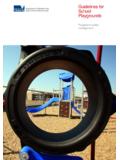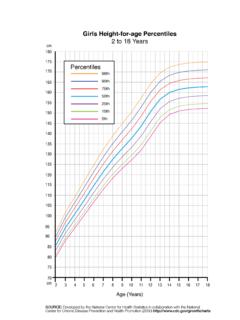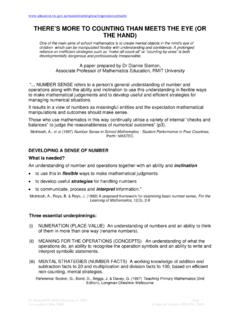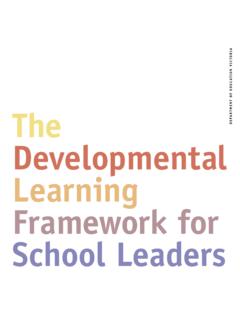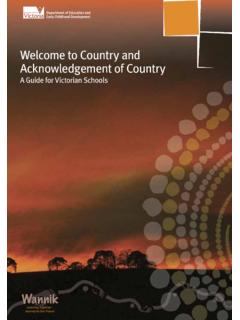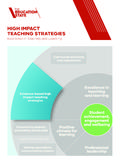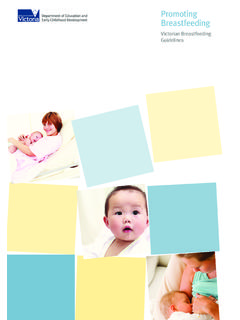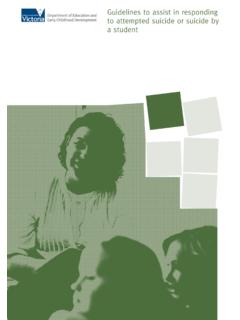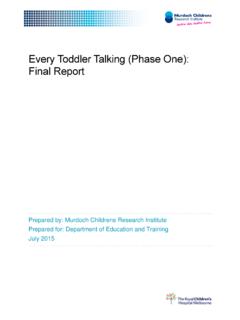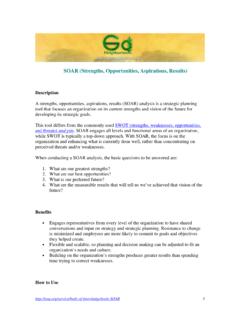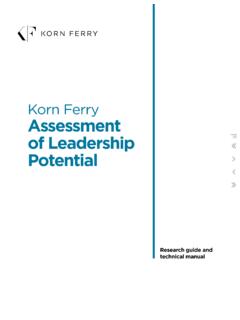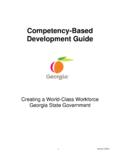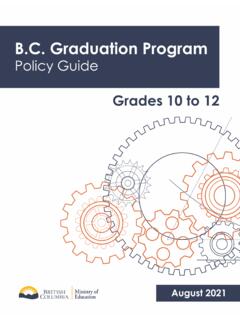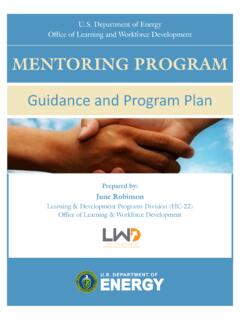Transcription of Practice Principle 3: High expectations for every child
1 T Victorian Early Years Learning and Development Framework Evidence Paper Practice Principle 3: High expectations for every child Authored for the Department of Education and Early Childhood Development by Madeleine Saffigna, Amelia Church & Collette Tayler 2 Practice Principle 3: High expectations for every child Executive Summary .. 4 Introduction .. 5 What do we mean by high expectations for every child ? .. 6 Why are high expectations for every child so important in early childhood learning, development and teaching? .. 7 Children learn best when they are expected to succeed.. 7 Low expectations affect how children see themselves, and are often linked to socioeconomic, racial, cultural or gender bias.
2 8 High expectations act as protective factors, by promoting resilience in children who are considered at risk .. 9 Early childhood professionals who have high expectations for every child are also more likely to take responsibility for children s learning and have a high level of teacher How can we achieve best Practice ? .. 11 Early childhood professionals critically reflect on bias and promote equality in their learning environments through high expectations for every child ..11 Early childhood professionals communicate these expectations to children..11 Early childhood professionals advocate for high expectations with parents, colleagues and other professionals ..12 Early childhood professionals use strengths-based approaches that value and extend each child s strengths, abilities and unique qualities.
3 12 Early childhood professionals provide assessment and feedback to parents that is developmentally appropriate, strengths-based and allows each child to experience success..14 Early childhood professionals have high expectations for themselves. They view themselves as agents of change and are confident in their ability to be effective educators..15 What are the implications for achieving best outcomes for children? .. 16 Appendix A Methodology .. 17 References .. 19 3 The Victorian Early Years Learning and Development Framework guides early childhood professionals Practice in Victoria. The Victorian Framework identifies eight Practice Principles for Learning and Development ( Practice Principles). The Practice Principles are based on the P-12 Principles of Learning and Teaching, the pedagogy from the national Early Years Learning Framework, and are informed by the latest research.
4 The Practice Principles are interrelated and designed to inform each other. They are categorised as Collaborative, Effective and Reflective: Collaborative 1. Family-centred Practice 2. Partnerships with professionals 3. High expectations for every child Effective 4. Equity and diversity 5. Respectful relationships and responsive engagement 6. Integrated teaching and learning approaches 7. Assessment for learning and development Reflective 8. Reflective Practice These Evidence Papers document the research that underpins each Practice Principle . The content of the Evidence Papers will be developed into a series of practical guides Practice Principles in Practice which will provide practical advice to early childhood professionals on how to align their Practice to the Practice Principles.
5 4 Executive Summary The Victorian Early Years Learning and Development Framework is for all children in Victoria. At the core of this inclusive framework is the Practice Principle High expectations for every child . This evidence paper presents the research to support this Practice Principle . It is the right of every child to receive an education that promotes their individual learning path. This Practice Principle emphasises the uniqueness of each child s experience, learning and development and this paper summarises evidence to support best Practice . The expectations of professionals impact directly on children s motivation, self-esteem and self-efficacy (Uszynska-Jarmoc, 2007; Morales, 2010).
6 The evidence clearly shows that children who develop strong self-esteem, sense of agency and academic motivation are more likely to achieve their potential at school as well as being resilient to risk factors throughout their education (Brown & Medway, 2007; Gizir & Aydin, 2009). High expectations for every child require early childhood professionals to consider multiple ways of knowing and learning, to value children s strengths and differences and to use these in their assessment and planning. In order to support each child s learning trajectory, early childhood professionals must take responsibility for each child s learning and development. This includes finding new ways to learn, providing additional support, reflecting on best Practice and persistence in responding to challenges.
7 The implications for Practice informed by the research and detailed in this paper are: Early childhood professionals communicate high expectations to every child , every day. Early childhood professionals provide differentiated learning environments that promote many ways of knowing and learning. Early childhood professionals employ a strengths- and interest-based curriculum that allows each child to experience success. Early childhood professionals promote high expectations for every child through communication with families and other professionals. Early childhood professionals take responsibility for children s learning and development. 5 Introduction Children achieve better outcomes when they are expected to succeed.
8 Practice Principle 3: High expectations for every child reflects the commitment of professionals to support each child s individual learning trajectory. every child has the ability to learn and develop. Having high expectations is especially important in achieving better outcomes for the most vulnerable children. Some children require additional supports and different learning experiences and opportunities to help them learn and develop. Early childhood professionals: commit to high expectations for all children s learning and development ensure that every child experiences success in their learning and development recognise that every child can learn, but some children require quite different opportunities and supports to do this work with families to support children s learning and development at home and in the community.
9 VEYLDF, This evidence paper presents the research supporting Practice Principle 3: High expectations for every child . It is widely accepted that having high expectations for each child is effective teaching Practice (DEECD, 2009; DEEWR and COAG, 2009; DEC/NAEYC, 2009; Sammons, Hillman & Mortimer, 1995). Research demonstrates that children achieve better outcomes in learning environments where early childhood professionals have high expectations for every child (Halvorsen, Lee & Andrade, 2009). This is especially true for children who are considered at risk (Hinnant, O Brien & Ghazarian, 2009). High expectations from both early childhood professionals and parents can enhance children s resilience, achievement, motivation and self-belief (Gizir & Aydin, 2009; Ahmed, Minnaert, Van Der, & Kuyper, 2008).
10 When educators have low expectations of their students it impacts directly on children s self-confidence, belief in their own abilities, sense of agency and their academic outcomes (Rubie-Davies, 2006). High expectations for every child also recognises that each child is different and has a unique learning trajectory, meaning that each child will require unique support to reach his or her full potential (UN Committee on the Rights of the 6 child , UN Children s Fund & Bernard van Leer Foundation, 2006; Ireson, 2008; MacNaughton, 2003). High expectations can be achieved by: believing that each child is capable of learning communicating high expectations to children and parents taking responsibility for children s learning and reflecting on teaching Practice .
